Mesoscale Analysis and Numerical Simulation of an Extreme Precipitation Event on the Northern Slope of the Middle Kunlun Mountains in Xinjiang, China
Abstract
1. Introduction
2. Data
2.1. Datasets
2.2. Precipitation Observations
3. Results
3.1. Synoptic Situation and Environmental Factors Affecting Extreme Precipitation
3.1.1. Synoptic Situation
3.1.2. Low-Level Easterly Jet
3.1.3. Water Vapour Transport
3.1.4. Analysis of Thermodynamic and Dynamical Conditions
3.2. Experimental Design and Validation of the Weather Research and Forecasting Model
3.2.1. Experimental Design
3.2.2. Validation of Simulation Results
3.3. Analysis of Radar Echo Characteristics, Shear Lines, Evolution of Low-Level Jet, and Momentum Budget
3.3.1. Radar Echoes, Shear Lines, and Evolution of Low-Level Jet
3.3.2. Momentum Budget Analysis
4. Discussion
5. Conclusions
Author Contributions
Funding
Data Availability Statement
Acknowledgments
Conflicts of Interest
References
- Tao, S.Y. Heavy Rainfall in China; Science Press: Beijing, China, 1980; p. 225. [Google Scholar]
- Zhang, J.L.; Yang, X.; Shi, J.J. Analysis of the influence of the Qinghai-Xizang Plateau weather system on a rare rainstorm process on the northern slope of Kunlun Mountain. Plateau Meteor. 2021, 40, 1002–1011. [Google Scholar]
- Kunkel, K.E.; Karl, T.R.; Brooks, H.; Kossin, J.; Lawrimore, J.H.; Arndt, D.; Bosart, L.; Changnon, D.; Cutter, S.L.; Doesken, N.; et al. Monitoring and understanding trends in extreme storms: State of knowledge. Bull. Am. Meteorol. Soc. 2013, 94, 499–514. [Google Scholar] [CrossRef]
- Duan, W.; He, B.; Takara, K.; Luo, P.; Hu, M.; Alias, N.E.; Nover, D. Changes of precipitation amounts and extremes over Japan between 1901 and 2012 and their connection to climate indices. Clim. Dyn. 2015, 45, 2273–2292. [Google Scholar] [CrossRef]
- Yang, L.M. Climate change of extreme precipitation in Xinjiang. Acta Geogr. Sin. 2003, 58, 577–583. [Google Scholar]
- Dai, X.G.; Ren, Y.Y.; Chen, H.W. Multi-Scale feature of climate and climate shift in Xinjiang over the past 50 years. Acta Meteo. Sin. 2007, 65, 1003–1010. [Google Scholar]
- Yao, J.Q.; Chen, J.; Zhou, G.X.; Mao, W.Y. Reasearch on heavy rainfall in Southern Xinjiang: Scientific knowledge and research advances. Desert Oasis Meteorol. 2024, 18, 1–8. [Google Scholar]
- Jin, C.; He, Q.; Huang, Q. A review on rainstorm research in southern Xinjiang. Trans. Atmos. Sci. 2023, 46, 82–96. [Google Scholar]
- Chen, Y.; Deng, H.; Li, B.; Li, Z.; Xu, C. Abrupt change of temperature and precipitation extremes in the arid region of Northwest China. Quat. Int. 2014, 336, 35–43. [Google Scholar] [CrossRef]
- Wang, B.; Zhang, M.; Wei, J.; Wang, S.; Li, S.; Ma, Q.; Li, X.; Pan, S. Changes in extreme events of temperature and precipitation over Xinjiang, northwest China, during 1960–2009. Quat. Int. 2013, 298, 141–151. [Google Scholar] [CrossRef]
- Li, H.H.; Min, Y.; Li, A.B.; Li, R.Q. Comparative analysis of on water vapour characteristics of two extreme rainstorms in the north slope of Kunlun Mountains. Arid. Land Geogr. 2022, 45, 715–724. [Google Scholar]
- Zhang, J.L.; Li, N.; Qing, H.; Li, J.G.; Liu, J.; Liu, W.; Mikribanu, E. The observational analysis and water vapour characteristics of a rainstorm in Xinjiang. Torrential Rain Disasters 2016, 35, 537–545. [Google Scholar]
- Huang, Y.; Yu, X.D.; Chen, T.Y.; Tang, P. Analysis of conceptual models and ambient parameter of short time severe rainfall in South Xinjiang. Meteor. Mon. 2018, 44, 1033–1041. [Google Scholar]
- Zhuang, X.C.; Li, B.Y.; Qing, R.; Li, R.Q.; Zhang, Y.H.; Bai, S.Z. Analysis on the causes of an extreme rainstorm in the eastern Xinjiang. Plateau Meteor. 2020, 39, 947–959. [Google Scholar]
- Lü, X.S.; Zhou, Y.M.; Yu, X.J.; Yu, B.X.; Wang, X. Temporal and spatial variation characteristics of rainstorm flood disaster loss in Xinjiang during 1961–2019. Desert Oasis Meteorol. 2021, 15, 42–49. [Google Scholar]
- Wang, X.Q.; Wang, X. Spatial distribution and temporal variation characteristics of rainstorm flood disasters with different intensities in southern Xinjiang from 1980 to 2019. J. Glaciol. Geocry 2021, 43, 1818–1828. [Google Scholar]
- Tang, P.; Huang, Y.; Zhang, L.; Chen, T.Y.; Yang, X.F. Causation analysis of an extreme torrentaial rain on the north slope of middle Kunlun Mountain. Desert Oasis Meteorol. 2022, 16, 34–41. [Google Scholar]
- Zhao, D.S.; Gao, X.; Wu, S.H.; Zheng, D. Trend of climate variation in China from 1960 to 2018 based on natural regionalization. Adv. Earth Sci. 2020, 35, 750–760. [Google Scholar]
- Lu, S.; Hu, Z.Y.; Wang, B.P.; Qin, P.; Wang, L. Spatio-temporal Patterns of Extreme Precipitation Events over China in Recent 56 Years. Plateau Meteor. 2020, 39, 683–693. [Google Scholar]
- Wang, C.H.; Zhang, S.N.; Zhang, F.M.; Li, K.C.; Yang, K. On the increase of precipitation in the Northwestern China under the global warming. Adv. Earth Sci. 2021, 36, 980–989. [Google Scholar]
- Yang, X.; Zhou, H.K.; Xu, T.T.; Hua, Y. Comparative analysis of the fine characteristics of different rainstorms in southern Xinjiang during summer. Arid Zone Res. 2021, 38, 747–756. [Google Scholar]
- Chen, D.D.; Dai, Y.J. Characteristics and analysis of typical anomalous summer rainfall patterns in Northwest China over the last 50 years. Chin. J. Atmos. Sci. 2009, 33, 1247–1258. [Google Scholar]
- Yang, L.M.; Zhang, Q.Y. Surface latent heat flux characteristics over Tibetan Plateau and circulations of summer precipitation anomalies in south Xinjiang. Plateau Meteor. 2007, 26, 435–441. [Google Scholar]
- Lu, X.; Zhao, Y.; Wang, T.Z. Analysis on the circulation differences of summer rainfall over Xinjiang. Desert Oasis Meteorol. 2021, 15, 84–91. [Google Scholar]
- Zhang, Y.H.; Li, H.Y.; Lin, X.L.; Abulimiti; Yu, B.X. Analysis of continuous rainstorm circulation background and the dynamic process of synoptic scale in west of southern Xinjiang. Meteor. Mon. 2015, 41, 816–824. [Google Scholar]
- Zhou, X.Y.; Jia, J.; Liu, G.Q.; Qiu, H.M.; Yang, L. Comparative analysis of circulation background and dry intrusion of two spring heavy rainfall events in south Xinjiang. Meteorol. Sci. Technol. 2018, 46, 1201–1210. [Google Scholar]
- Yang, X.; Zhang, Y.H.; Zhang, C.; Yu, B.X.; Mu, H. Causation analysis of the 21 May 2018 torrential rain in west of southern Xinjiang. Desert Oasis Meteorol. 2020, 14, 21–30. [Google Scholar]
- Zeng, Y.; Yang, L.M. Comparative analysis on mesoscale characteristics of two severe short-time precipitation events in the west of southern Xinjiang. Torr. Rain Dis. 2017, 36, 410–421. [Google Scholar]
- Liu, W.; Li, J.G.; Yang, L.M. Characteristics of the MCS over southern Xinjiang during the late summer of 2016. Desert Oasis Meteorol. 2017, 11, 9–16. [Google Scholar]
- Xie, Z.M.; Zhou, S.Y.; Yang, L.M. Review of study on precipitation in Xinjiang. Torrential Rain Disasters 2018, 37, 204–212. [Google Scholar]
- Ji, C.H.; Li, S.X. Analysis on extremity of the “7·19” severe rainstorm process in Kaifeng. Meteor. Environ. Sci. 2021, 44, 53–62. [Google Scholar]
- Mao, Z.Y.; Li, G.P.; Xu, L. Analysis ontransport and budget characteristics of water vapour in a sustained heavy rain event in Hunan Province. Torrential Rain Disasters 2021, 40, 513–522. [Google Scholar]
- Liu, G.Q.; Tong, X.Y.; Deng, J.; Zhou, X.Y.; Zhou, C.L.; Liu, C.Y. Analysis of water vapour transport characteristics in Xinjiang based on the Lagrangian and Euler method. Desert Oasis Meteorol. 2019, 13, 22–31. [Google Scholar]
- Su, A.F.; Lü, X.N.; Cui, L.M.; Li, Z.; Xi, L.; Li, H. The basic observational analysis of “7.20” extreme rainstorm in Zhengzhou. Torrential Rain Disasters 2021, 40, 445–454. [Google Scholar]
- Feng, L.S.; Song, P.; Tian, L.; Gu, X.J.; Zhang, X.Y.; Han, Y. Meteorological condition diagnosis and transmission impact analysis of three heavy pollution processes in Henan province. Meteor. Environ. Sci. 2020, 43, 104–113. [Google Scholar]
- Yu, X.J.; Zhao, Y. Simulation of orographic effects on summer rain in the Tianshan mountains. J. Desert Res. 2016, 36, 1133–1143. [Google Scholar]
- Ye, L.M.; Wu, N.G.; Zhang, H.L.; Cai, J.J.; Wu, Z.F. Analysis of the influence of sea-land breeze and topography on the extraordinary heavy rain in warm sector under a weak weather background. Torrential Rain Disasters 2019, 38, 597–605. [Google Scholar]
- Liu, Y.N.; Liu, X.M.; Zou, H.B.; Wu, J. Analysis of terrain effect for a heavy rainstorm in northwestern Jiangxi by numerical simulation. Meteor. Dis. Red Res. 2021, 44, 105–114. [Google Scholar]
- Zhou, T.J.; Qian, Y.F. An experimental study on the effects of topography on numerical prediction. Sci. Atmos. Sin. 1996, 20, 452–462. [Google Scholar]
- Liao, F.; Hu, Y.M.; Hong, Y.C. Numerical study for the influences of orographic dynamicon cloud and precipitation in North China. Plateau Meteor. 2009, 28, 115–126. [Google Scholar]
- Liu, J.Y.; Mao, L.J.; Niu, T.; Chen, M.; Liu, H.L.; Wang, J.Z. Numerical simulation study on the impact of topographic forcing on the disaster rainstorm in West China in September 2011. Meteor. Mon. 2013, 39, 975–987. [Google Scholar]
- Xiong, Q.F.; Hu, J.L.; Zhang, Y.C. Terrain effects in numerical simulation of Meiyu front heavy rain. J. Meteor. Sci. 2007, 6, 591–596. [Google Scholar]
- Liu, Y.L.; Huang, Y. Study of Huangshan mountain terrain on precipitation enhancement condition. Plateau Meteor. 2013, 32, 2608–2615. [Google Scholar]
- Ding, R.H.; Ding, X. Analysis on precipitation differences between Jiuhua mountains and its surrounding regions. Meteor. Mon. 2014, 40, 458–465. [Google Scholar]
- Ma, S.H.; Xi, Y.W. Some regularities of storm rainfall in Xinjiang, China. Acta Meteor. Sin. 1997, 2, 239–248. [Google Scholar]
- Wu, H.; Xu, X.; Luo, T.; Yang, Y.; Xiong, Z.; Wang, Y. Variation and comparison of cloud cover in MODIS and four reanalysis datasets of ERA-interim, ERA5, MERRA-2 and NCEP. Atmos. Res. 2023, 281, 106477. [Google Scholar] [CrossRef]
- Jiménez, P.A.; Dudhia, J.; González-Rouco, J.F.; Navarro, J.; Montávez, J.P.; García-Bustamante, E. A revised scheme for the WRF surface layer formulation. Mon. Weather Rev. 2012, 140, 898–918. [Google Scholar] [CrossRef]
- Ju, C.; Li, H.; Li, M.; Liu, Z.; Ma, Y.; Mamtimin, A.; Sun, M.; Song, Y. Comparison of the forecast performance of WRF using noah and noah-mp land surface schemes in central Asia arid region. Atmosphere 2022, 13, 927. [Google Scholar] [CrossRef]
- Xin, Y.; Li, M.; Du, J.; Yang, Z.Z.; Yuan, B.; Wang, Y.F. The development of Xinjiang meteorology in exploiting data assimilation operational system. Desert Oasis Meteorol. 2021, 15, 133–143. [Google Scholar]
- Duolaite, X. Formulation of precipitation intensity standard of Xinjiang. Desert Oasis Meteorol. 2005, 28, 7–8. [Google Scholar]
- Chen, F.; Dudhia, J. Coupling an advanced land surface-hydrology model with the Penn State-NCAR MM5 modeling system. Part II: Preliminary model validation. Mon. Weather Rev. 2001, 129, 587–604. [Google Scholar] [CrossRef]
- Ek, M.B.; Mitchell, K.E.; Lin, Y.; Rogers, E.; Grunmann, P.; Koren, V.; Gayno, G.; Tarpley, J.D. Implementation of Noah land surface model advances in the National Centers for Environmental Prediction operational mesoscale Eta model. J. Geophys. Res. 2003, 108, 8851. [Google Scholar] [CrossRef]
- Mahrt, L.; Ek, M. The influence of atmospheric stability on potential evapouration. J. Clim. Appl. Meteor. 1984, 43, 170–181. [Google Scholar]
- Kramer, M.; Heinzeller, D.; Hartmann, H.; Wim, V.; Stetneveld, G. Assessment of MPAS variable resolution simulations in the grey-zone of convection against WRF model results and observations. Clim. Dyn. 2020, 55, 253–276. [Google Scholar] [CrossRef]
- Thompson, G.; Field, P.R.; Rasmussen, R.M.; Rasmussen, R.M.; Hall, W.D. Explicit forecasts of winter precipitation using an Improved bulk microphysics scheme. Part II: Implementation of a new snow parameterization. Mon. Weather Rev. 2008, 36, 5095–5115. [Google Scholar] [CrossRef]
- Hong, S.-Y.; Noh, Y.; Dudhia, J. A new vertical diffusion package with an explicit treatment of entrainment processes. Mon. Weather Rev. 2006, 134, 2318–2341. [Google Scholar] [CrossRef]
- Alapaty, K.; Niyogi, D.; Chen, F.; Pyle, P.; Chandrasekar, A.; Seaman, N. Development of the flux-adjusting surface data assimilation system for mesoscale models. J. Appl. Meteorol. Climatol. 2008, 47, 2331–2350. [Google Scholar] [CrossRef]
- Wu, W.J.; He, J.H.; Hyo-Sang, C.; Chun-Ho, C. The relationship between the East Asian Up-tropopheric jet stream in summer and climatic characteristics of synoptic-scale disturbance. Clim. Environ. Res. 2006, 11, 525–534. [Google Scholar]
- Chi, J.; Zhou, Y.S.; Ran, L.K.; Zhou, K.; Shen, X.Y. Numerical simulation analysis on the generation and evolution of the dynamic and thermodynamic processes of an extreme rainfall in Jilin province. Chin. J. Atmos. Sci. 2021, 45, 1400–1414. [Google Scholar]
- Li, X.M.; Yang, L.M.; Li, J.G.; Liu, J. Mesoscale convective systems characteristic analysis of the “6·14” extreme rainstorm in northern slope of the Kunlun Mountains. Arid. Land Geogr. 2024, 47, 1700–1712. [Google Scholar]
- Chen, Q.S. The instability of the gravity-inertia wave and its relation to low-level jet and heavy rainfall. J. Meteorol. Soc. Jpn. Ser. II 1982, 60, 1041–1057. [Google Scholar] [CrossRef]
- Sun, J.S. A study of the basic features and mechanism of boundary layer jet in Beijing area. Chin. J. Atmos. Sci. 2005, 29, 445–452. [Google Scholar]
- Zhong, Z.; Yuan, H.H.; Li, J.; Fan, H.Y. Characteristics of meso-scale perturbation and momentum transportation associated with an intensification process of upper-level jet. J. Meteor. Sci. 2010, 30, 639–645. [Google Scholar]
- Zhang, L.N.; Ran, L.K.; Li, N.; Du, J.; Zhou, X.; Meng, Y. Analysis of momentum flux and kinetic energy flux transport in the middle and lower troposphere during a thunderstorm event. Chin. J. Atmos. Sci. 2018, 42, 178–191. [Google Scholar]
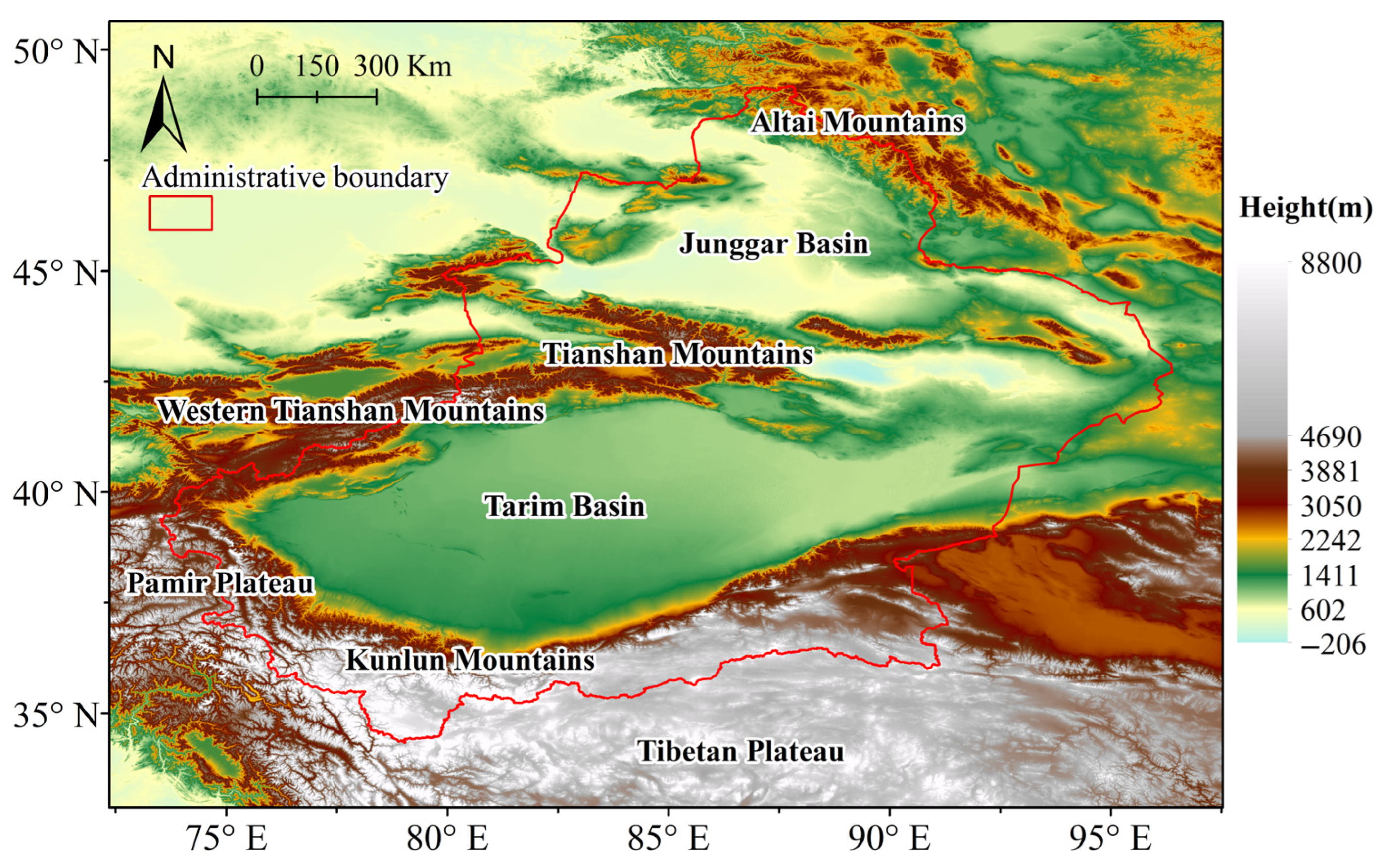
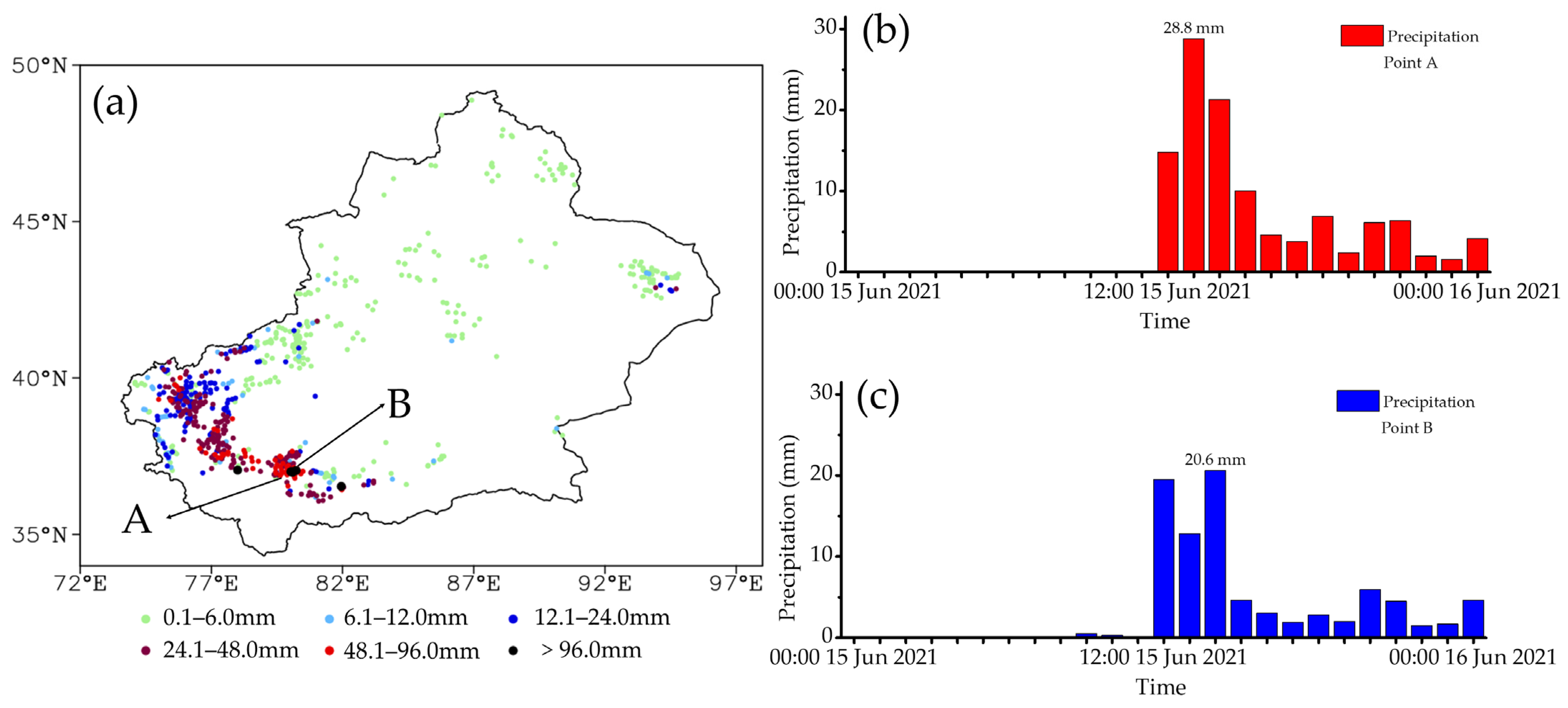
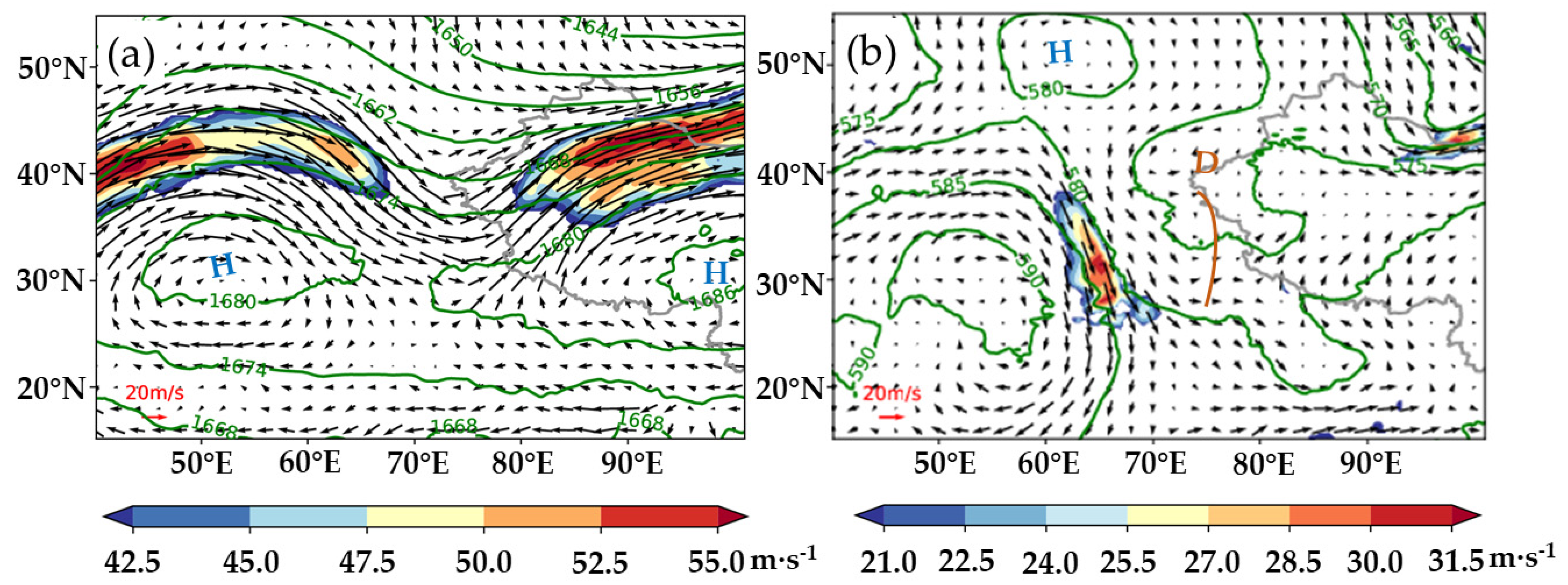
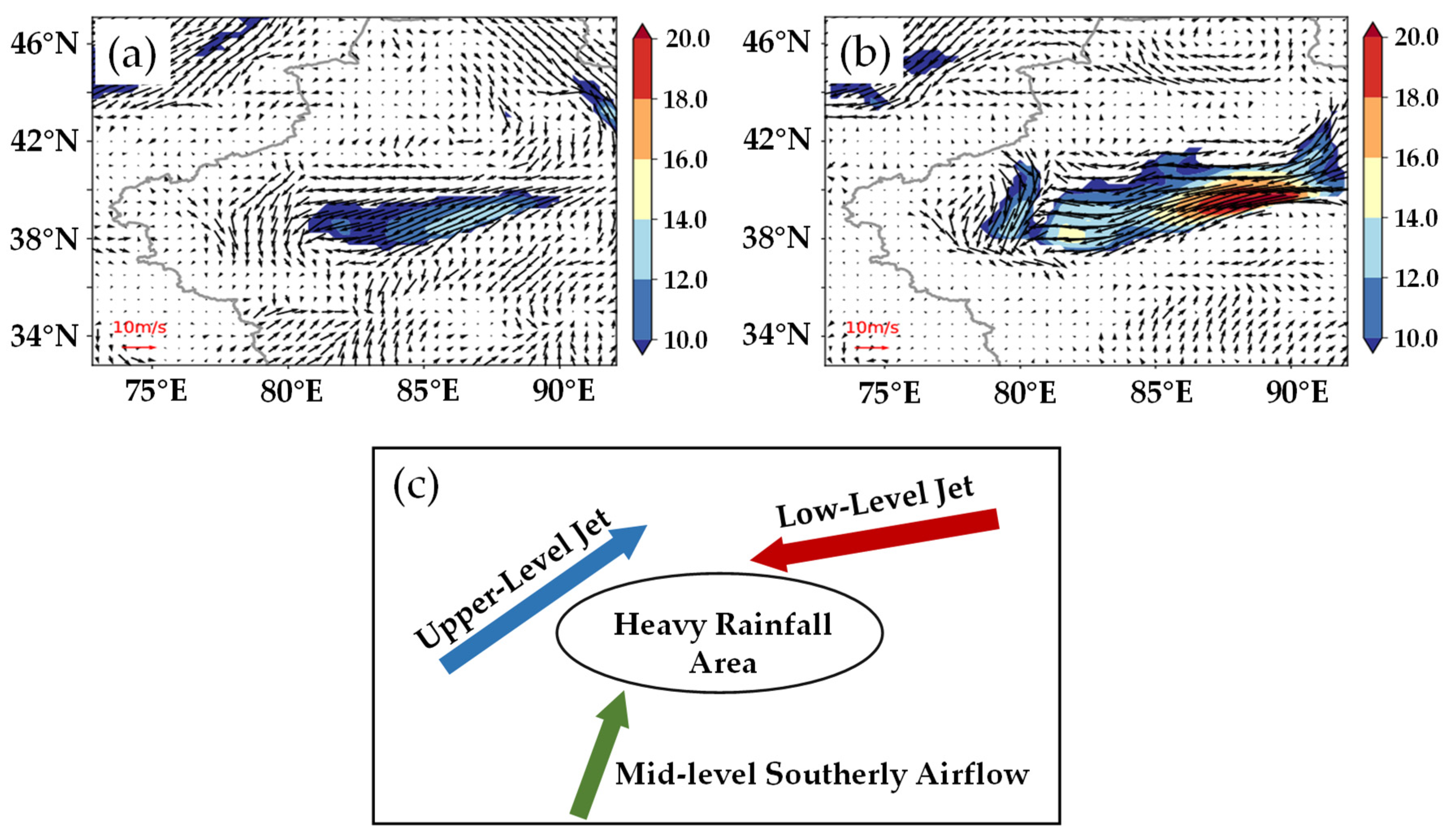
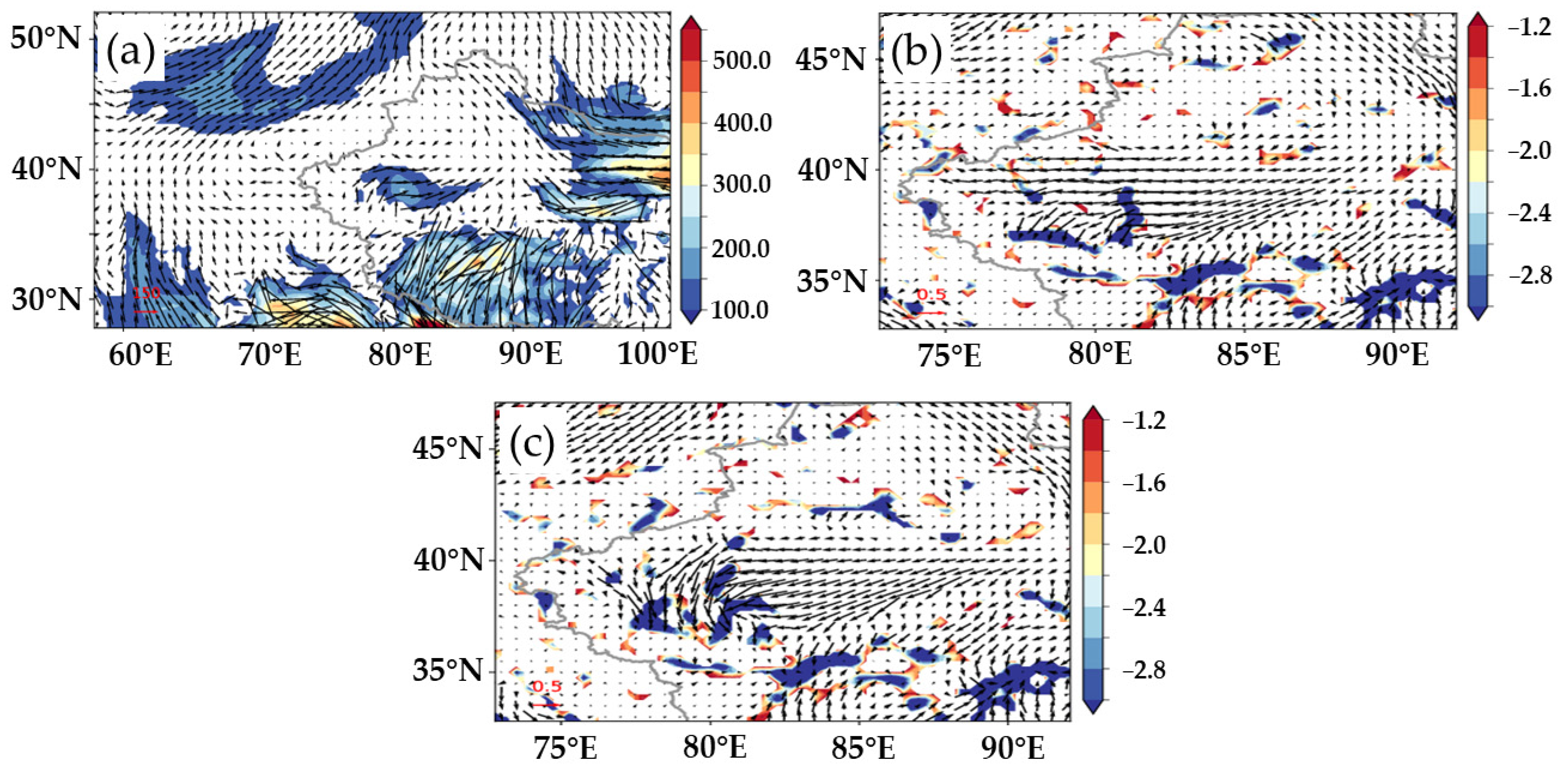
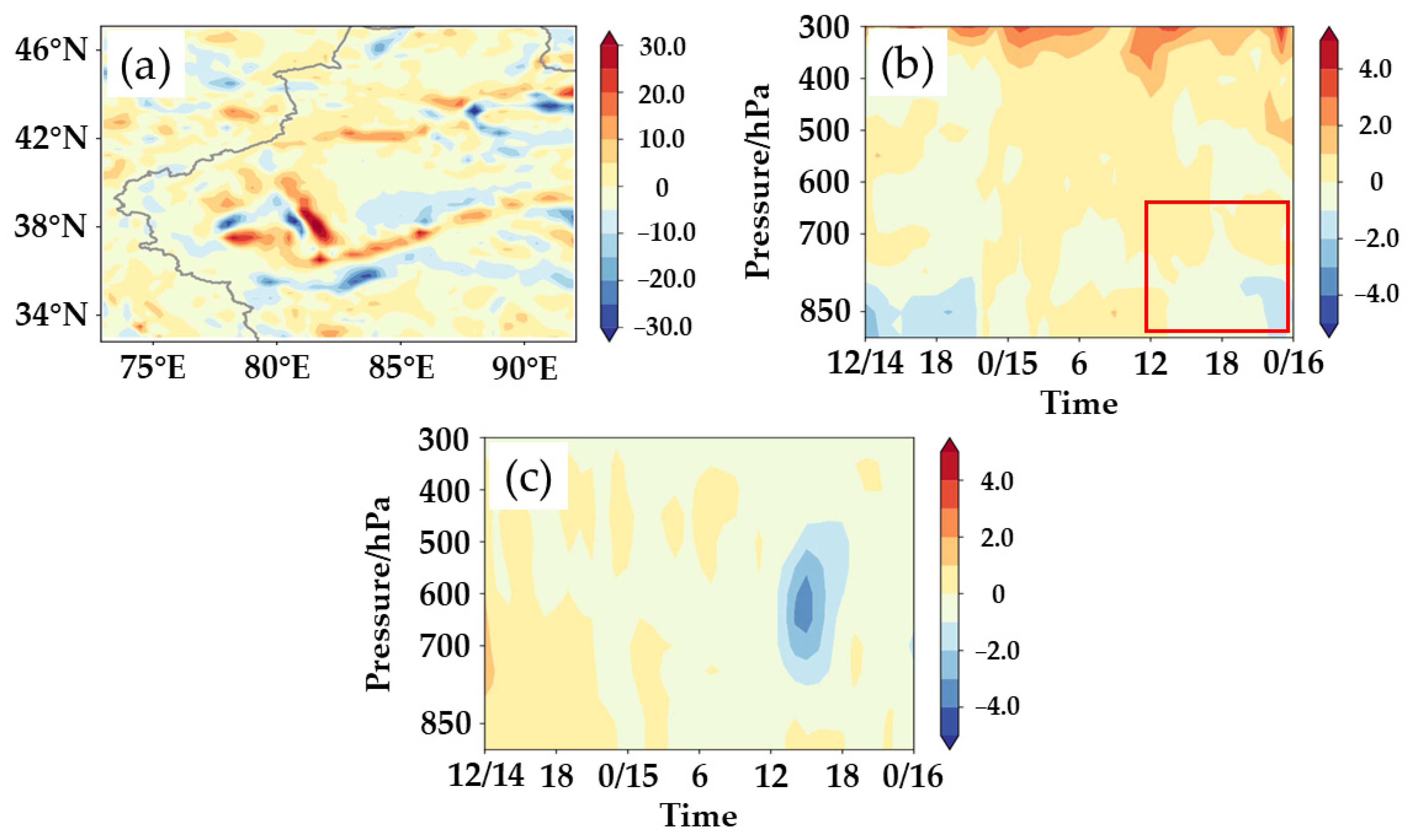
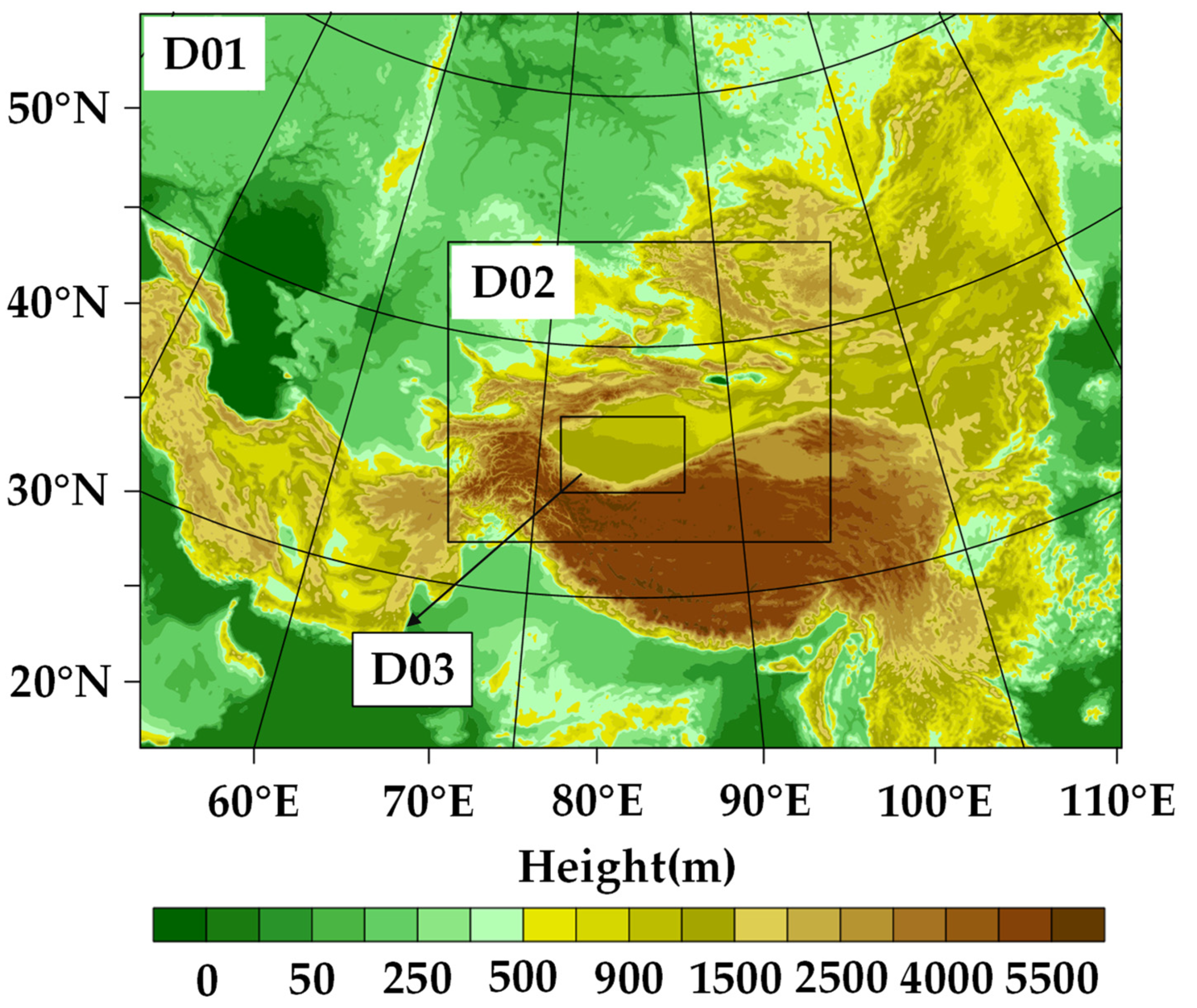
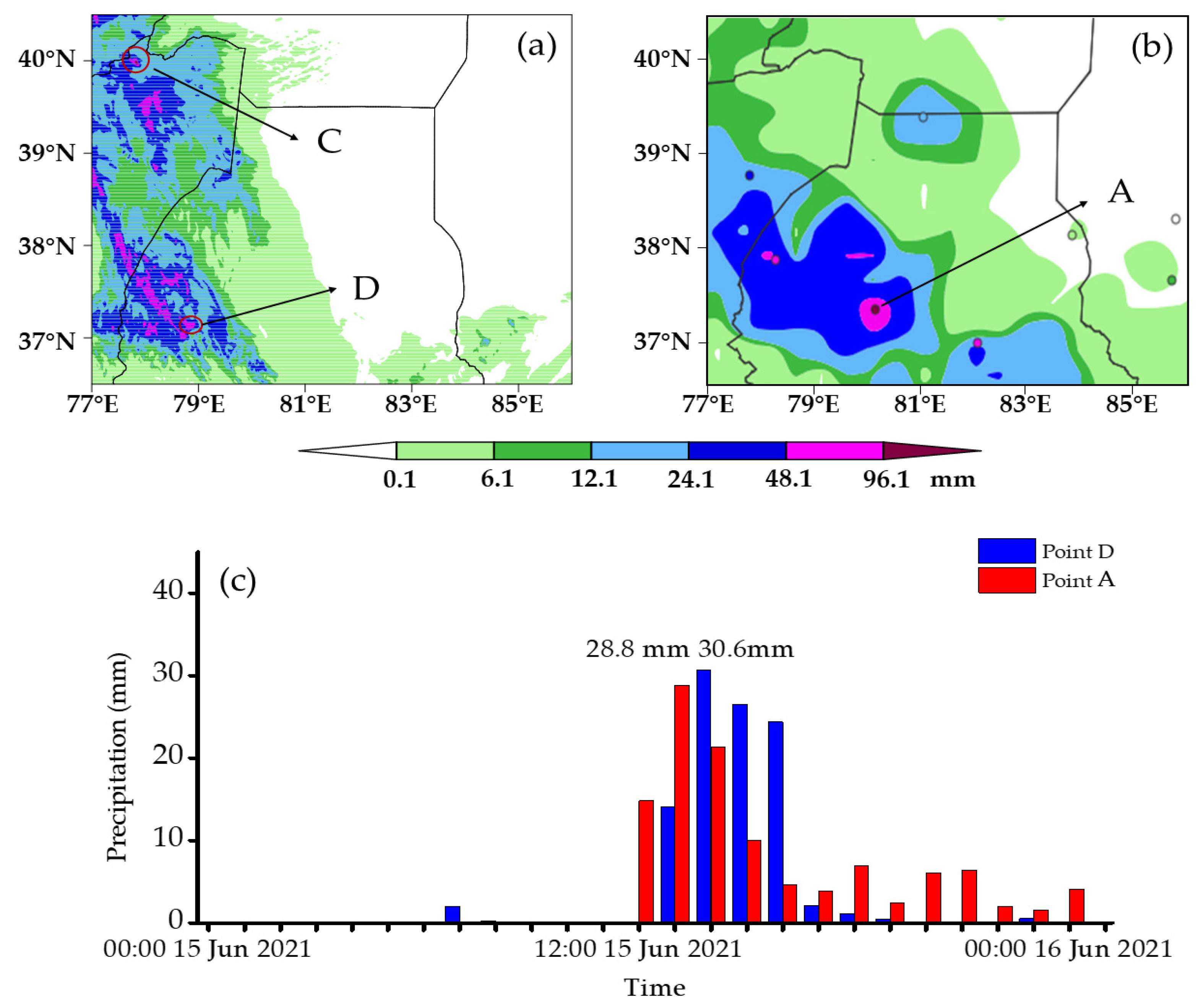
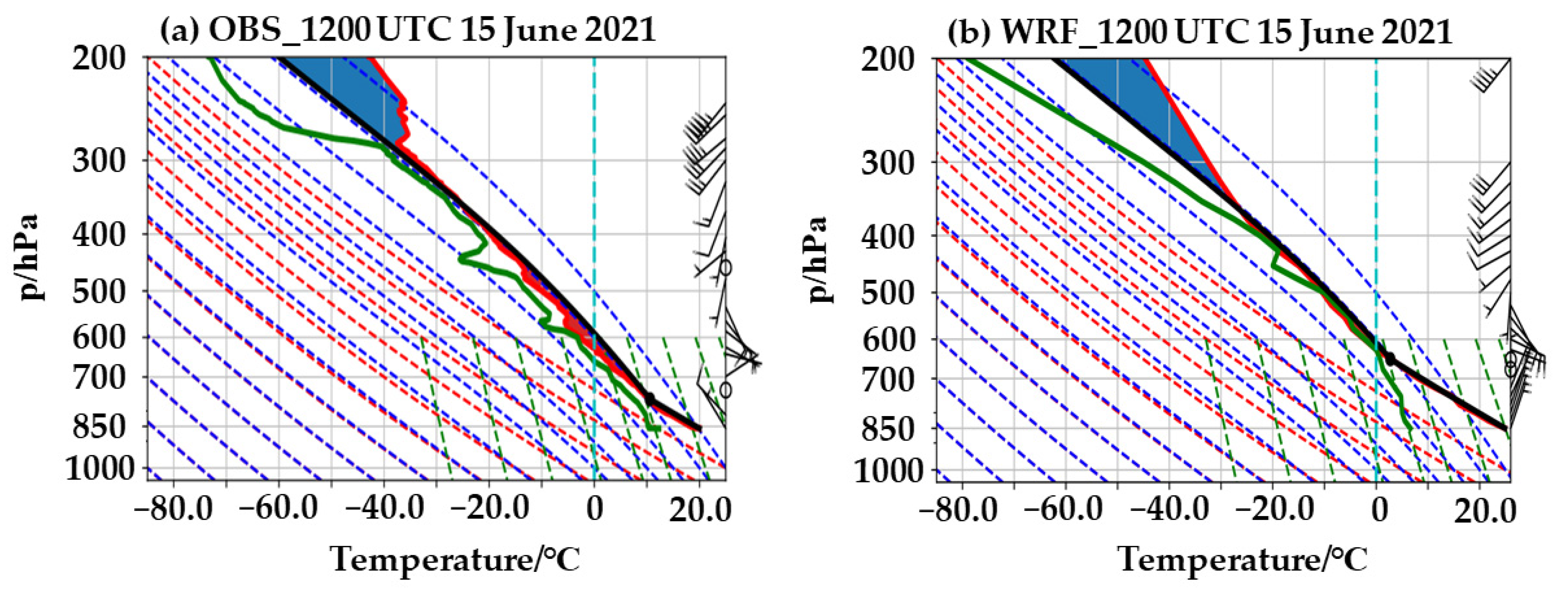
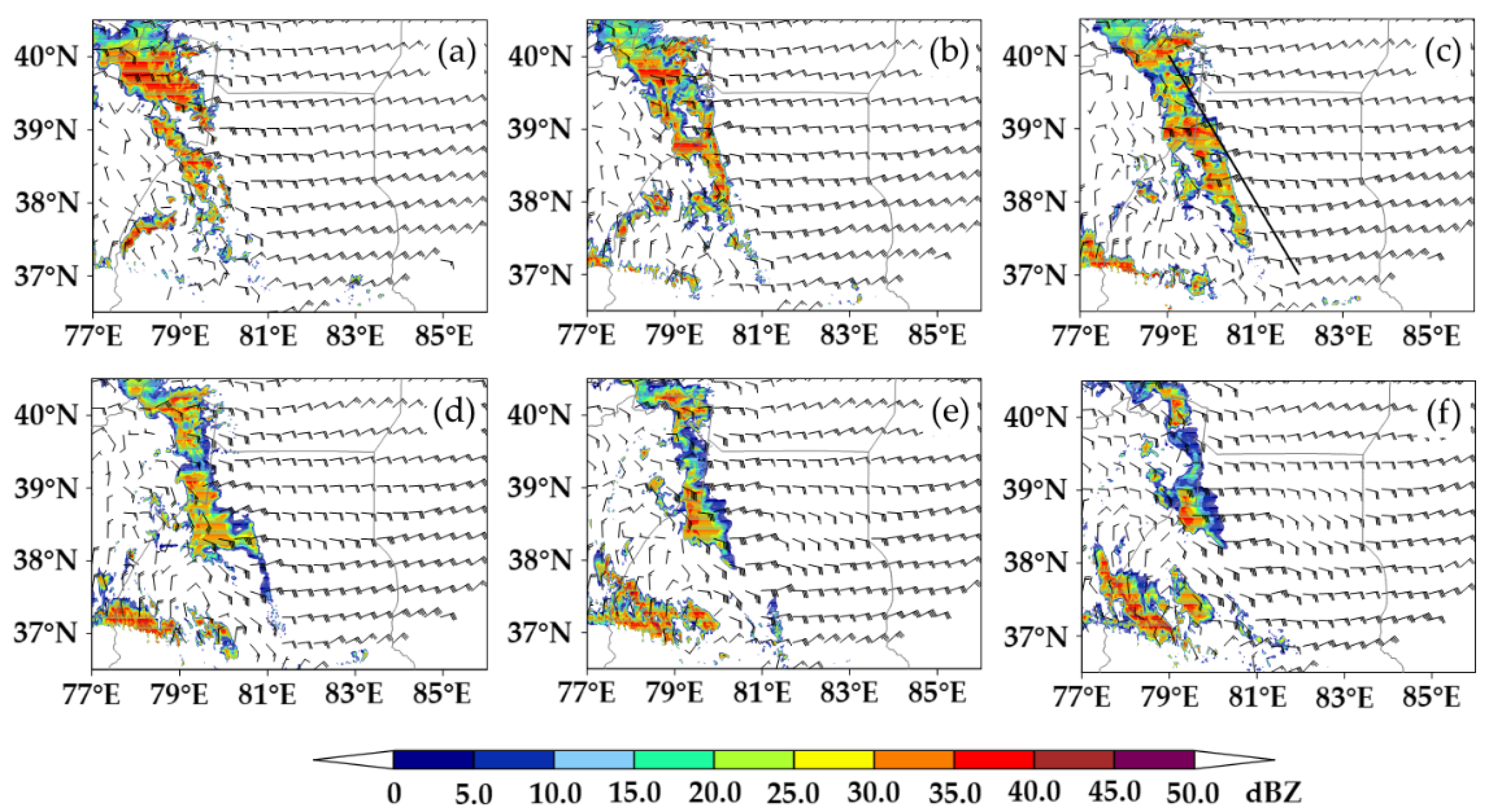
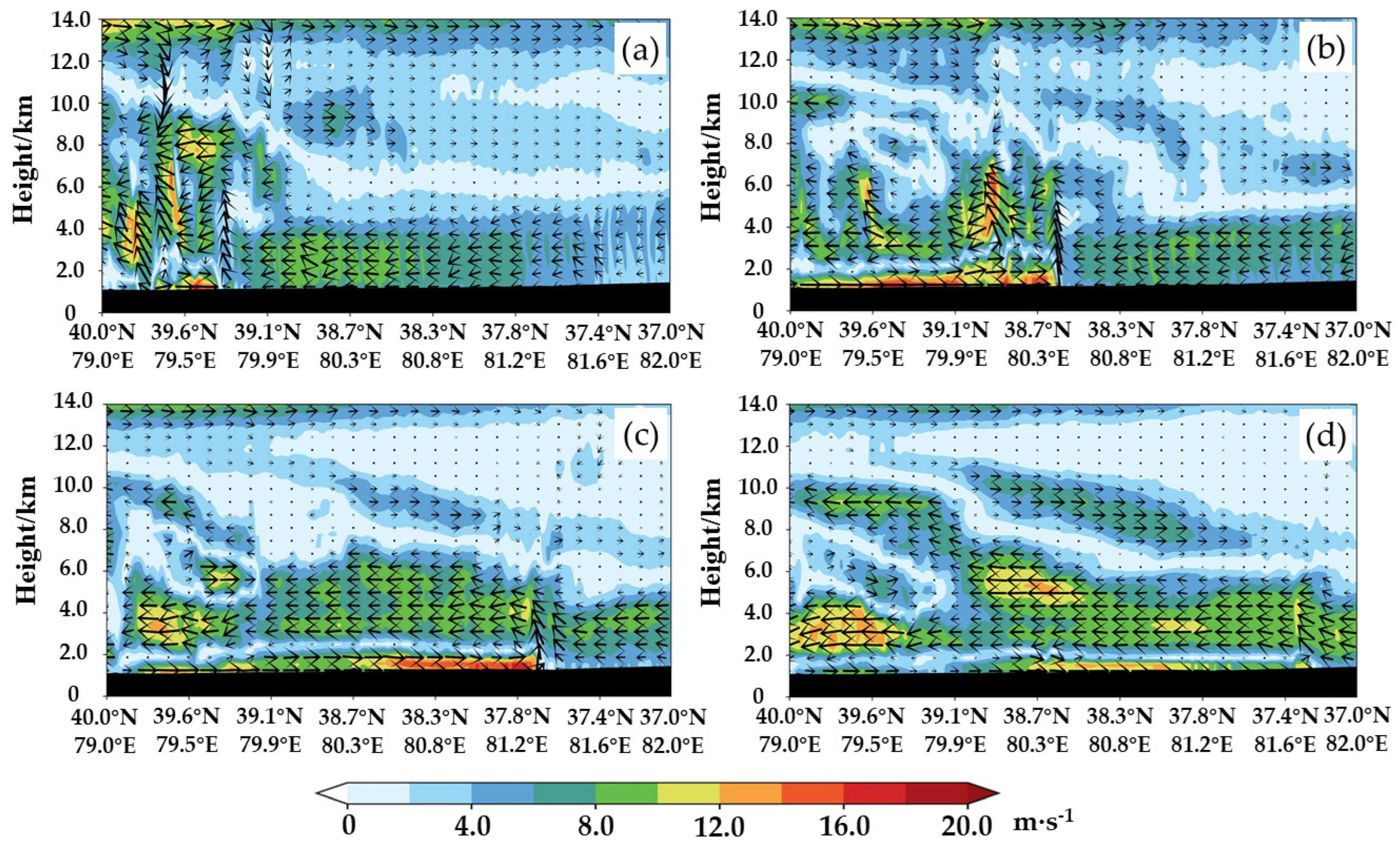
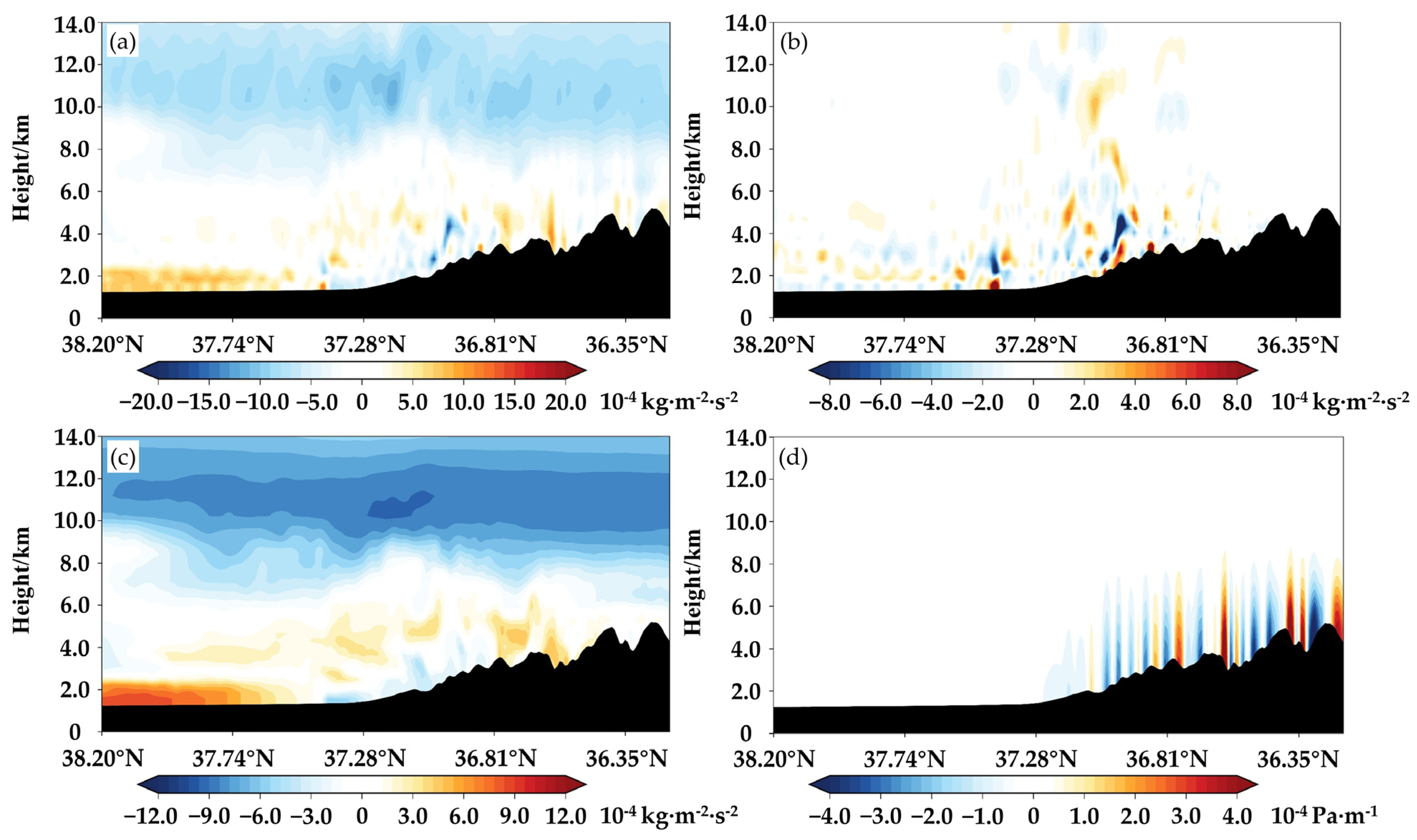
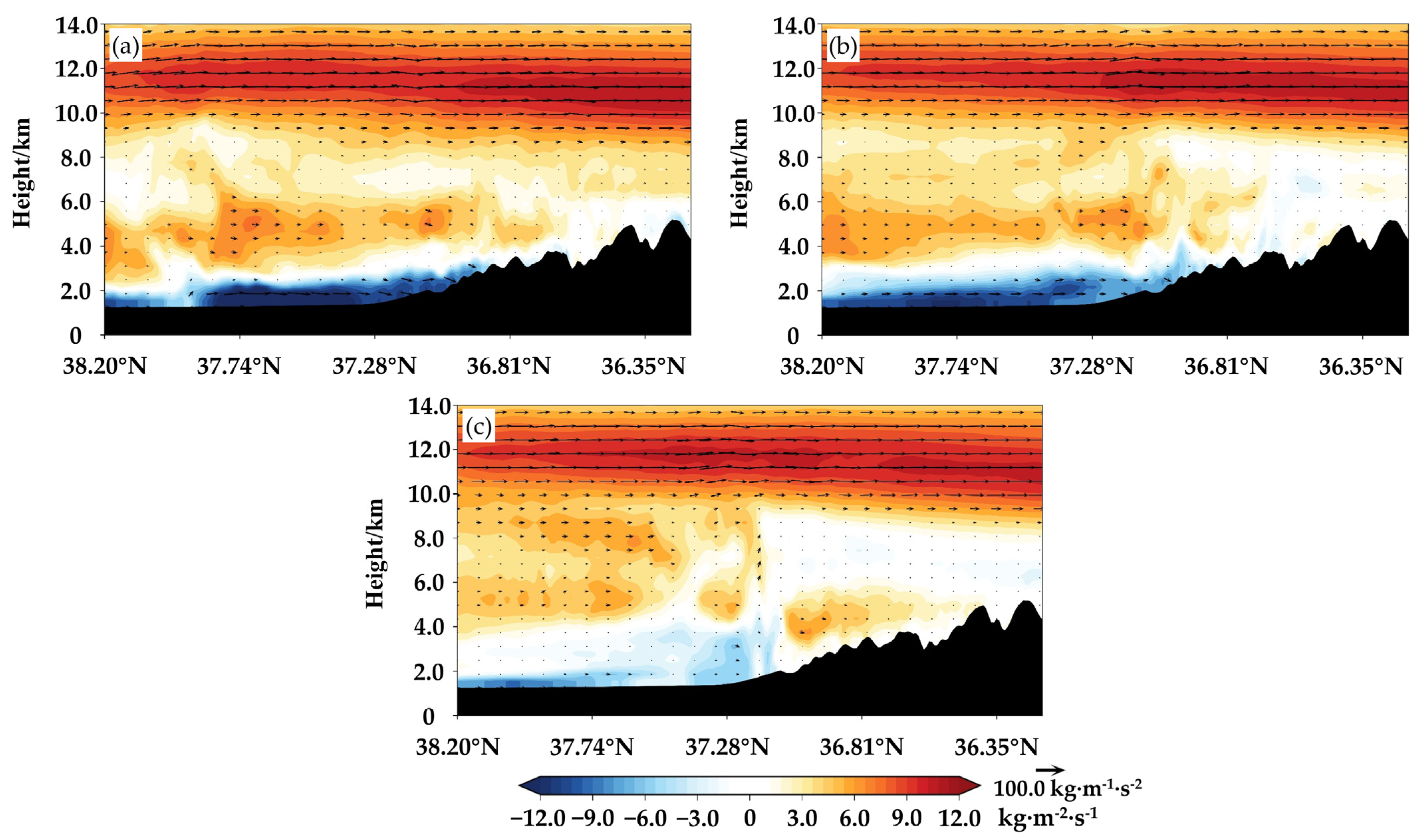
| D01 | D02 | D03 | |
|---|---|---|---|
| Horizontal grid spacing | 9 km | 3 km | 1 km |
| Horizontal grid number | 712 × 532 | 832 × 652 | 808 × 496 |
| Long-wave radiation scheme | Rapid radiative transfer model for general circulation models (RRTMG) scheme | RRTMG scheme | RRTMG [54] scheme |
| Short-wave radiation scheme | RRTMG scheme | RRTMG scheme | RRTMG [54] scheme |
| Microphysics scheme | New Thompson scheme | New Thompson scheme | New Thompson [55] scheme |
| Surface layer scheme | Revised Mesoscale Model version 5 (MM5) | Revised MM5 scheme | Revised MM5 [47] scheme |
| Planetary boundary layer scheme | Yonsei University (YSU) scheme | YSU scheme | YSU [56] scheme |
| Land-surface scheme | Noah | Noah | Noah [57] |
Disclaimer/Publisher’s Note: The statements, opinions and data contained in all publications are solely those of the individual author(s) and contributor(s) and not of MDPI and/or the editor(s). MDPI and/or the editor(s) disclaim responsibility for any injury to people or property resulting from any ideas, methods, instructions or products referred to in the content. |
© 2025 by the authors. Licensee MDPI, Basel, Switzerland. This article is an open access article distributed under the terms and conditions of the Creative Commons Attribution (CC BY) license (https://creativecommons.org/licenses/by/4.0/).
Share and Cite
Ju, C.; Li, M.; Yang, X.; Wulayin, Y.; Aihaiti, A.; Li, Q.; Shao, W.; Yao, J.; Liu, Z. Mesoscale Analysis and Numerical Simulation of an Extreme Precipitation Event on the Northern Slope of the Middle Kunlun Mountains in Xinjiang, China. Remote Sens. 2025, 17, 2519. https://doi.org/10.3390/rs17142519
Ju C, Li M, Yang X, Wulayin Y, Aihaiti A, Li Q, Shao W, Yao J, Liu Z. Mesoscale Analysis and Numerical Simulation of an Extreme Precipitation Event on the Northern Slope of the Middle Kunlun Mountains in Xinjiang, China. Remote Sensing. 2025; 17(14):2519. https://doi.org/10.3390/rs17142519
Chicago/Turabian StyleJu, Chenxiang, Man Li, Xia Yang, Yisilamu Wulayin, Ailiyaer Aihaiti, Qian Li, Weilin Shao, Junqiang Yao, and Zonghui Liu. 2025. "Mesoscale Analysis and Numerical Simulation of an Extreme Precipitation Event on the Northern Slope of the Middle Kunlun Mountains in Xinjiang, China" Remote Sensing 17, no. 14: 2519. https://doi.org/10.3390/rs17142519
APA StyleJu, C., Li, M., Yang, X., Wulayin, Y., Aihaiti, A., Li, Q., Shao, W., Yao, J., & Liu, Z. (2025). Mesoscale Analysis and Numerical Simulation of an Extreme Precipitation Event on the Northern Slope of the Middle Kunlun Mountains in Xinjiang, China. Remote Sensing, 17(14), 2519. https://doi.org/10.3390/rs17142519







